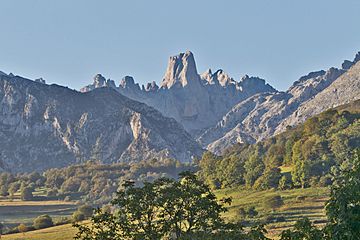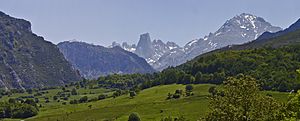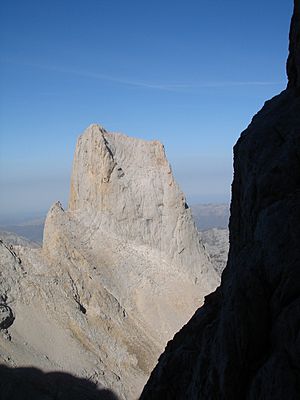Naranjo de Bulnes facts for kids
Quick facts for kids Picu Urriellu |
|
|---|---|

Naranjo de Bulnes.
|
|
| Highest point | |
| Elevation | 2,519 m (8,264 ft) |
| Prominence | 500 m (1,600 ft) |
| Naming | |
| English translation | Picu Urriellu |
| Language of name | Asturian |
| Geography | |
| Location | Asturias, Spain |
| Parent range | Cantabrian Mountains - Picos de Europa |
| Climbing | |
| First ascent | August 5, 1904, Pedro Pidal |
| Easiest route | from Refugio Vega d'Urriellu. |
The Naranjo de Bulnes is a famous limestone mountain in Spain. It's also known as Picu Urriellu in the Asturian language. This amazing peak is part of the Picos de Europa mountain range in Asturias. Its name, Picu Urriellu, probably comes from "Los Urrieles," which is the name for the central part of the Picos de Europa.
The mountain is made of limestone rock that formed a very long time ago, during the Paleozoic Era. It's located in the Cabrales area of Asturias and is part of the Picos de Europa National Park.
The name "Naranjo de Bulnes" first appeared in a map in 1855 by a German geologist named Wilhelm Phillip Daniel Schulz. But local people have always called it "Picu Urriellu." No one is really sure why it was called "Naranjo" (which means orange tree), but some think it's because the rock has an orange color. The people from the nearby village of Bulnes even have a saying: "Don't call me Orange tree, because fruit I cannot bear, call me Picu Urriellu which is my natural name."
Picu Urriellu is 2,529 meters (about 8,297 feet) tall. Even though it's not the tallest mountain in the Cantabrian range, it's super famous among climbers in Spain. This is especially true for its huge 550-meter (about 1,800 feet) high west face, which is popular for a type of climbing called big wall climbing. At the bottom of the peak, there's a valley called Vega Urriellu, which was shaped by glaciers long ago.
First Climbs of Picu Urriellu
This section tells you about the brave climbers who first reached the top of Picu Urriellu.
The First Ascent (1904)
The very first time someone climbed Picu Urriellu was on August 5, 1904. A Spanish nobleman named Pedro Pidal, 1st Marquess of Villaviciosa de Asturias and a shepherd named Gregorio Perez, also known as "El Cainejo," made this historic climb. They went up the north face of the mountain using a route now called the Vía Pidal.
First Solo Climb (1906)
On October 1, 1906, a German geology professor and skilled climber named Gustav Schulze made the second climb of Urriellu. He also used the north face, but he was the first person to climb it all by himself! He was also the first to use special climbing tools called pins to help him get down the south face. He had climbed big mountains in the Alps before, and he said this climb was "short and difficult."
Local Climbers and New Routes
Victor Martínez Campillo, who lived in the nearby town of Bulnes, climbed the mountain on August 31, 1916, using the same route as Pidal. He even found parts of the rope that Pidal and Perez had left behind. Victor climbed it again in 1923 and, in 1924, he opened a new, easier route on the south face, which is now called Vía Victor.
On July 7, 1928, a climber named Andrés Espinosa from Biscay climbed the south face alone without ropes. This was a very impressive climb and only the second of its kind on the mountain.
A month later, on August 8, Manuel Martinez Campillo (Victor's cousin) found a new way to climb, called the Horizontal Pass. This route is on the right side of the south face and is now one of the most popular ways to go up.
On August 13, 1944, Victor Martínez's two sons, Alfonso and Juan, opened another route on the south face. It's known as the "Vía Sur" or "Martínez Direct Line" and is one of the most used and safest routes today.
First Winter Climb (1956)
Climbing in winter is much harder because of snow and ice. On March 23, 1954, a group of climbers tried to make the first winter climb but had to stop because of dangerous avalanches. However, on March 8, 1956, Ángel Landa Bidarte and Pedro Udaondo were the first to successfully reach the top in winter conditions.
The Difficult West Face (1962)
The west face of Picu Urriellu is very challenging. On August 21, 1962, two climbers from Aragon, Alberto Rabadá and Ernesto Navarro, were the first to successfully climb this difficult face.
Later, on February 8, 1973, two teams made the first winter climb of the "Vía Rabadá y Navarro" on the West Face. This climb was watched closely by the news because that winter had been very tough for climbers.
Modern Challenges (2009)
On September 4, 2009, two brothers, Iker and Eneko Pou, climbed Urriellu in just 8 hours using the Orbayu route. This route is known as one of the hardest free climbing routes in the world!
You can also reach the "Pandébano Col" from the town of Bulnes. To get to Bulnes, you can either walk or take a special train called a Funicula railway.
Climbing Routes on Picu Urriellu
Picu Urriellu has many climbing routes, especially for big wall climbing, which means climbing very tall, steep rock faces. Here are some of the most important ones:
West Face Routes
- Rabadá y Navarro (750m, MD+, 6a, A1 [6c+])
- Leiva. (500m, 7a / [6b,A1] )
- Sagitario. (200m, 6b)
- Directísima. (500m, 7b / [6a,A2] )
- Murciana 78. (500m, 7c+ / [6a,A2] )
- Mediterráneo. (500m, [6b,A3] )
- Pilar del Cantábrico. (500m, 8a+ / [6a,A2+] )
- Orbayu: This is known as one of the most difficult free climbing routes ever opened on a mountain. The Pou brothers opened it in September 2009. It's 500 meters high and has parts that are extremely challenging (difficulty of 8c+y9a).
North Face Routes
- Régil. (700m, V)
- Pidal-Cainejo. (450m, V). This was the route used for the very first climb of Naranjo de Bulnes on August 5, 1904.
East Face Routes
- Cepeda. (350m, 6a)
- Pájaro Loco. (200m, 6b)
- Martínez-Somoano. (250m, V+ expo)
- Amistad con el Diablo. (200m, V+ expo)
- Cainejo. (260m, 7b / [6a+, A1])
South Face Routes
- Nani. (300m, V+)
- Directa Hermanos Martínez. (155m, V-)
- Invicto y Laureado. (160m, 6a+, obl. 6a)
- Me refugio en la bebida. (145m, 7a, obl. 6c)
- Pecadillu. (300m, 6c, obl. 6b).
When climbers finish their ascent, they often go down the south face using a route called the South Direct Line. This involves using ropes to rappel down in four sections. Be careful though, as some parts of "The Amphitheatre" area can have loose rocks.
See also
 In Spanish: Naranjo de Bulnes para niños
In Spanish: Naranjo de Bulnes para niños



